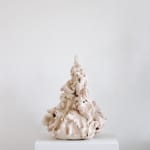





Alessandro Twombly
Cumulus Exorcism, 2016
White terracotta
44 x 35 cm
Copyright The Artist
Further images
Alessandro Twombly (b.1959, Italy) is an Italian artist best known for his organic, textured sculptures. He is currently based in Rome where his practice focuses on both painting and sculpture....
Alessandro Twombly (b.1959, Italy) is an Italian artist best known for his organic, textured sculptures. He is currently based in Rome where his practice focuses on both painting and sculpture.
Twombly’s sculptures frequently take on the guise of organic formations, such as solidified sea plants, corrals, or frozen lava flows. However, they are not representational, but rather appeal to the essential and invisible inner powers of nature. Their dynamic shapes visualise the idea of metamorphosis, the perpetual transformation that underlies growth, progress, and existence. The surface of the sculptures reveals the process of molding. Twombly uses traditional working techniques to form the shapes out of clay, terracotta or plaster prior to casting them in bronze or resin. The movements of his fingers are visible on the surface, and hence the creative practice is embedded into the artwork. Following the terminology of Roland Barthes, who stated the death of the author as the independence of a work from its creator, Twombly’s sculptures speak to the trace of the author – the sign of artist’s presence fused within the material itself.
Twombly’s sculptures frequently take on the guise of organic formations, such as solidified sea plants, corrals, or frozen lava flows. However, they are not representational, but rather appeal to the essential and invisible inner powers of nature. Their dynamic shapes visualise the idea of metamorphosis, the perpetual transformation that underlies growth, progress, and existence. The surface of the sculptures reveals the process of molding. Twombly uses traditional working techniques to form the shapes out of clay, terracotta or plaster prior to casting them in bronze or resin. The movements of his fingers are visible on the surface, and hence the creative practice is embedded into the artwork. Following the terminology of Roland Barthes, who stated the death of the author as the independence of a work from its creator, Twombly’s sculptures speak to the trace of the author – the sign of artist’s presence fused within the material itself.










